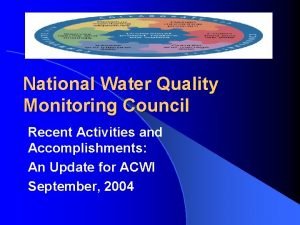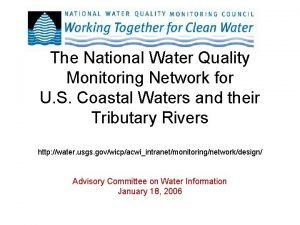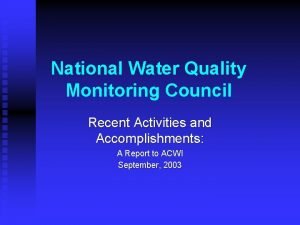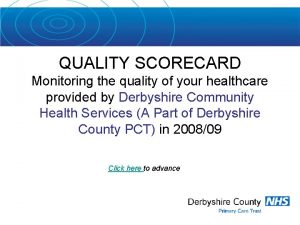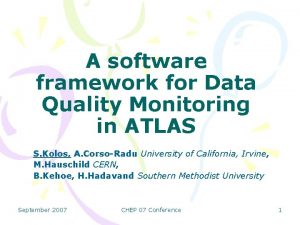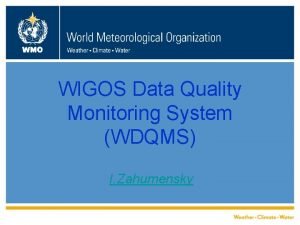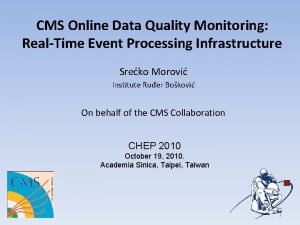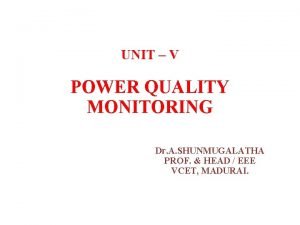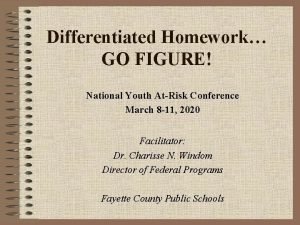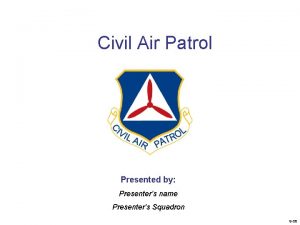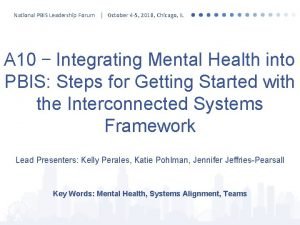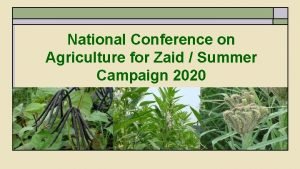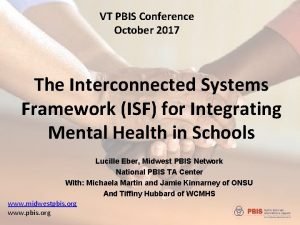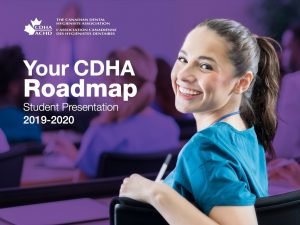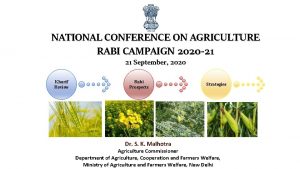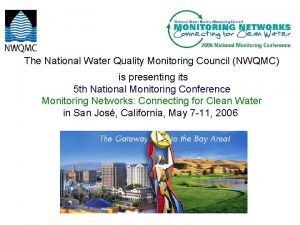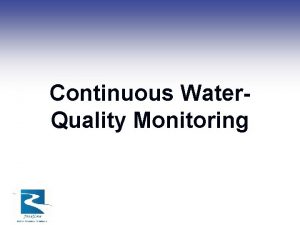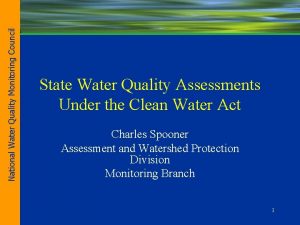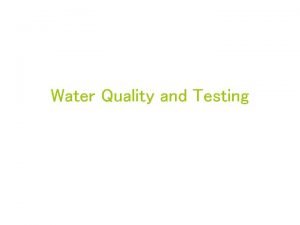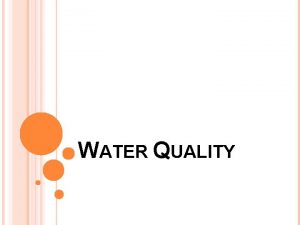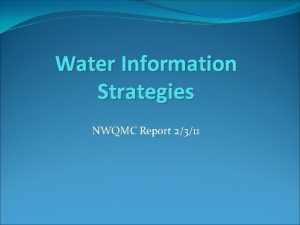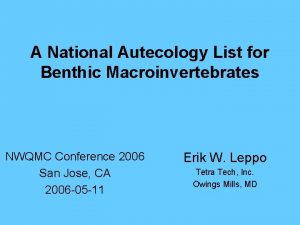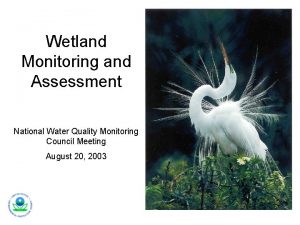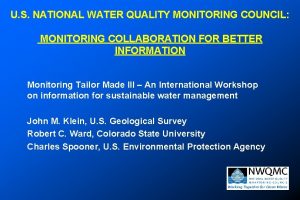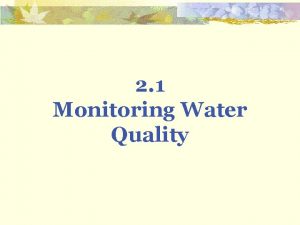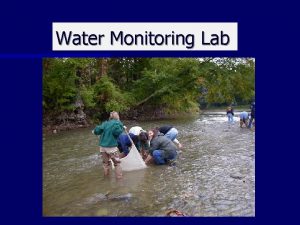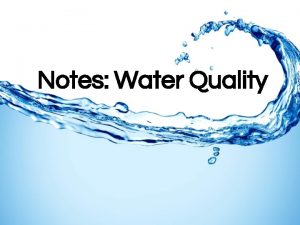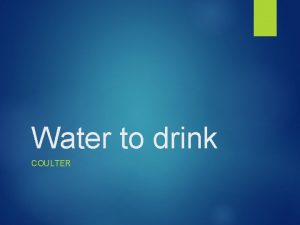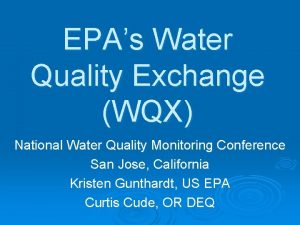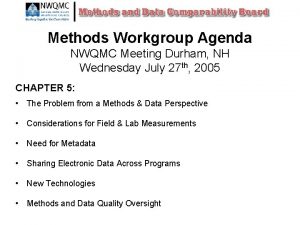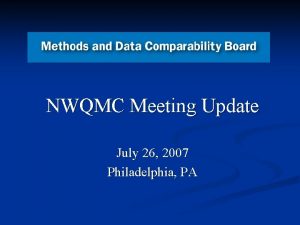National Water Quality Monitoring Conference NWQMC May 17




















- Slides: 20

National Water Quality Monitoring Conference (NWQMC) May 17 – May 20 2004 Chattanooga, USA Water Quality Data Assessment Saale River Basin, Thuringia, Germany K. Bongartz (a) & T. D. Steele (b) (a) University of Jena, Institute of Geography, Department of Geoinformatics, Remote Sensing and Modeling, Jena , Germany (b) TDS Consulting Inc. , Evergreen, Colorado, USA

Background Saale River Project Integrated Watershed Management in the Saale River Basin Development of an integrated methodology for sustainable watershed management Definition of ecological and economical measures Quantification of water-, nutrient - and constituent fluxes and their economical effects Development of measures for nutrient management and delineation of integrated flood prevention concepts Socio-economic evaluation- and decision support Support of local authorities and stakeholders during implementation of the EU Water Framework Directive through operational strategies and management options

Background EUWFD Management Plans for Sub-Watersheds (2009) Environment goals Status Quo River Monitoring Deficit Analysis Management Programs Achievement of Environment Goals “good status” (2015) Milestones Public Participation National Monitoring Conference May 17 - May 20 2004 Chattanooga (TN) , USA Klaus Bongartz Friedrich-Schiller-Universität Jena Department of Geoinformatics, Remote Sensing and Modeling

Introduction to the Saale River Basin 23719 km² Gauge: Calbe National Monitoring Conference May 17 – May 20 2004 Chattanooga (TN), USA Klaus Bongartz Friedrich-Schiller-Universität Jena Department of Geoinformatics, Remote Sensing and Modeling

Problems of point and non-point sources Problems of water demand allocation National Monitoring Conference May 17 – May 20 2004 Chattanooga (TN), USA Klaus Bongartz Friedrich-Schiller-Universität Jena Department of Geoinformatics, Remote Sensing and Modeling

r e ow p dro y H Competing stakeholders in the Saale River Basin n tio a rv re se on ltu u c i Agr C e r tu Na I n Mi e tur cul try i Agr s u nd re ltu u c i Agr n ing se u ic est tio a e r Rec m Do National Monitoring Conference May 17 – May 20 2004 Chattanooga (TN), USA Klaus Bongartz Friedrich-Schiller-Universität Jena Department of Geoinformatics, Remote Sensing and Modeling

Key Water-Quality Monitoring Sites Thuringia: 37 Stations with regular sampling (2 weeks) of 60 variables Saxony-Anhalt: 16 Stations with regular sampling (2 weeks) of 60 variables National Monitoring Conference May 17 – May 20 2004 Chattanooga (TN), USA Klaus Bongartz Friedrich-Schiller-Universität Jena Department of Geoinformatics, Remote Sensing and Modeling

Key stations used for this investigation Thuringia 5 mainstem Saale River sites 6 tributary sites (Source Thuringian Environmental Agency) Saxony-Anhalt 10 mainstem Saale River sites 4 tributary sites (Source: LAWA) National Monitoring Conference May 17 – May 20 2004 Chattanooga (TN), USA Klaus Bongartz Friedrich-Schiller-Universität Jena Department of Geoinformatics, Remote Sensing and Modeling

Period Record Statistics (Specific Conductance, NO 3, Zn) Thuringia National Monitoring Conference May 17 – May 20 2004 Chattanooga (TN), USA Saxony-Anhalt Klaus Bongartz Friedrich-Schiller-Universität Jena Department of Geoinformatics, Remote Sensing and Modeling

Average Flows and Runoff Variability Downstream National Monitoring Conference May 17 – May 20 2004 Chattanooga (TN), USA Klaus Bongartz Friedrich-Schiller-Universität Jena Department of Geoinformatics, Remote Sensing and Modeling

Regional variations in salinity (conductance) National Monitoring Conference May 17 – May 20 2004 Chattanooga (TN), USA Klaus Bongartz Friedrich-Schiller-Universität Jena Department of Geoinformatics, Remote Sensing and Modeling

Sources (Natural, Mining, Health Spas) National Monitoring Conference May 17 – May 20 2004 Chattanooga (TN), USA Klaus Bongartz Friedrich-Schiller-Universität Jena Department of Geoinformatics, Remote Sensing and Modeling

Using Nitrate as an Indicator for Nutrients Contrast Agriculture vs. Forested National Monitoring Conference May 17 – May 20 2004 Chattanooga (TN), USA Klaus Bongartz Friedrich-Schiller-Universität Jena Department of Geoinformatics, Remote Sensing and Modeling

Zinc as an indicator for trace metals Mining / Mineralisation Industry

Management considerations 1. ) Remediation of mine tailings (salinity and zinc) National Monitoring Conference May 17 – May 20 2004 Chattanooga (TN), USA Klaus Bongartz Friedrich-Schiller-Universität Jena Department of Geoinformatics, Remote Sensing and Modeling

2. ) Reduction of fertilizers and livestock in hotspot areas 1 Delineation of Nutrient Response Units 2 Implementation of RU into a neural Network 3 Targeting of an tolerable N-Input to the rivers 4 Calculation of areal specific fertilizer reduction to achieve the input target. b a b c Hydro. Net a c d g f e h i sematic neural Net d e f g h i j j k k l m small Change RU - Subareas m high Change l

Future Outlook Management Unit Saale River Basin Process models IRBDSS as integrated System Hydrology Nutrients Ecology Hydrology Ecology Asssessment Assessment National Monitoring Conference May 17 – May 20 2004 Chattanooga (TN), USA Klaus Bongartz Friedrich-Schiller-Universität Jena Department of Geoinformatics, Remote Sensing and Modeling

European Water Framework Directive: Goals There a number of objectives in respect of which the quality of water is protected. The key ones at European level are: general protection of the aquatic ecology, specific protection of unique and valuable habitats, protection of drinking water resources, and protection of bathing water (recreational use). All these objectives must be integrated for each river basin. The central requirement of the WFD is that the environment be protected to a high level in its entirety. Therefore at first the sampling methods, constituents, intervalls and data has to be homogenised between state authorities and in a second step between International water authorities National Monitoring Conference May 17 – May 20 2004 Chattanooga (TN), USA Klaus Bongartz Friedrich-Schiller-Universität Jena Department of Geoinformatics, Remote Sensing and Modeling

Stakeholder involvement • Problem survey • Target definition • Formulation of alternative activities • Assessment of results • Implementation of management measures National Monitoring Conference May 17 – May 20 2004 Chattanooga (TN), USA Klaus Bongartz Friedrich-Schiller-Universität Jena Department of Geoinformatics, Remote Sensing and Modeling

Thank you for your attention
 National water quality monitoring conference
National water quality monitoring conference Nwqmc conference
Nwqmc conference National water quality monitoring conference
National water quality monitoring conference National water quality monitoring council
National water quality monitoring council Water and water and water water
Water and water and water water Software quality assurance conference
Software quality assurance conference Quality monitoring scorecard
Quality monitoring scorecard Quality monitoring scorecard
Quality monitoring scorecard Data quality monitoring framework
Data quality monitoring framework Wdqms
Wdqms Real time data quality monitoring
Real time data quality monitoring Permanent power quality monitoring equipment
Permanent power quality monitoring equipment National youth at risk conference
National youth at risk conference Civil air patrol national conference
Civil air patrol national conference Aafp poster presentation
Aafp poster presentation Pbis national conference
Pbis national conference National conference on agriculture for summer campaign
National conference on agriculture for summer campaign Vt pbis
Vt pbis Cdha hotel discounts
Cdha hotel discounts National radiological emergency preparedness conference
National radiological emergency preparedness conference National conference for rabi campaign 2020
National conference for rabi campaign 2020
